Shasha Li
Step More: Going Beyond Single Backpropagation in Meta Learning Based Model Editing
Aug 06, 2025

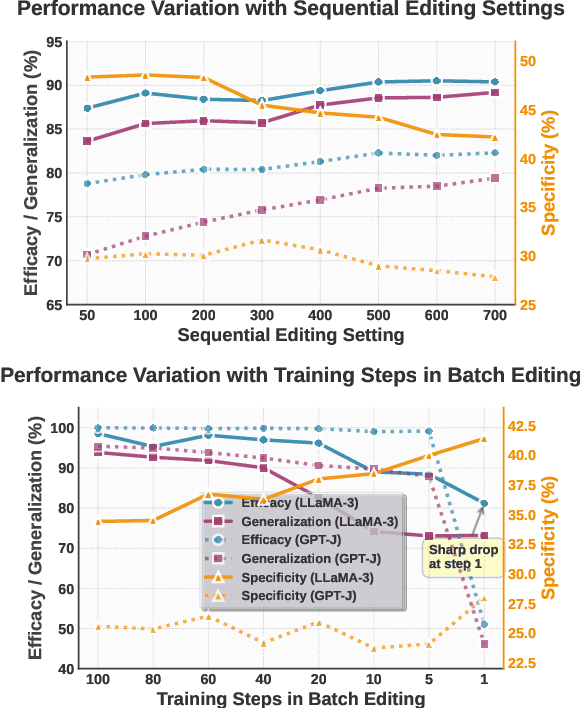

Abstract:Large Language Models (LLMs) underpin many AI applications, but their static nature makes updating knowledge costly. Model editing offers an efficient alternative by injecting new information through targeted parameter modifications. In particular, meta-learning-based model editing (MLBME) methods have demonstrated notable advantages in both editing effectiveness and efficiency. Despite this, we find that MLBME exhibits suboptimal performance in low-data scenarios, and its training efficiency is bottlenecked by the computation of KL divergence. To address these, we propose $\textbf{S}$tep $\textbf{M}$ore $\textbf{Edit}$ ($\textbf{SMEdit}$), a novel MLBME method that adopts $\textbf{M}$ultiple $\textbf{B}$ackpro$\textbf{P}$agation $\textbf{S}$teps ($\textbf{MBPS}$) to improve editing performance under limited supervision and a norm regularization on weight updates to improve training efficiency. Experimental results on two datasets and two LLMs demonstrate that SMEdit outperforms prior MLBME baselines and the MBPS strategy can be seamlessly integrated into existing methods to further boost their performance. Our code will be released soon.
Precise Zero-Shot Pointwise Ranking with LLMs through Post-Aggregated Global Context Information
Jun 12, 2025Abstract:Recent advancements have successfully harnessed the power of Large Language Models (LLMs) for zero-shot document ranking, exploring a variety of prompting strategies. Comparative approaches like pairwise and listwise achieve high effectiveness but are computationally intensive and thus less practical for larger-scale applications. Scoring-based pointwise approaches exhibit superior efficiency by independently and simultaneously generating the relevance scores for each candidate document. However, this independence ignores critical comparative insights between documents, resulting in inconsistent scoring and suboptimal performance. In this paper, we aim to improve the effectiveness of pointwise methods while preserving their efficiency through two key innovations: (1) We propose a novel Global-Consistent Comparative Pointwise Ranking (GCCP) strategy that incorporates global reference comparisons between each candidate and an anchor document to generate contrastive relevance scores. We strategically design the anchor document as a query-focused summary of pseudo-relevant candidates, which serves as an effective reference point by capturing the global context for document comparison. (2) These contrastive relevance scores can be efficiently Post-Aggregated with existing pointwise methods, seamlessly integrating essential Global Context information in a training-free manner (PAGC). Extensive experiments on the TREC DL and BEIR benchmark demonstrate that our approach significantly outperforms previous pointwise methods while maintaining comparable efficiency. Our method also achieves competitive performance against comparative methods that require substantially more computational resources. More analyses further validate the efficacy of our anchor construction strategy.
Rethinking the Residual Distribution of Locate-then-Editing Methods in Model Editing
Feb 06, 2025Abstract:Model editing is a powerful technique for updating the knowledge of Large Language Models (LLMs). Locate-then-edit methods are a popular class of approaches that first identify the critical layers storing knowledge, then compute the residual of the last critical layer based on the edited knowledge, and finally perform multi-layer updates using a least-squares solution by evenly distributing the residual from the first critical layer to the last. Although these methods achieve promising results, they have been shown to degrade the original knowledge of LLMs. We argue that residual distribution leads to this issue. To explore this, we conduct a comprehensive analysis of residual distribution in locate-then-edit methods from both empirical and theoretical perspectives, revealing that residual distribution introduces editing errors, leading to inaccurate edits. To address this issue, we propose the Boundary Layer UpdatE (BLUE) strategy to enhance locate-then-edit methods. Sequential batch editing experiments on three LLMs and two datasets demonstrate that BLUE not only delivers an average performance improvement of 35.59\%, significantly advancing the state of the art in model editing, but also enhances the preservation of LLMs' general capabilities. Our code is available at https://github.com/xpq-tech/BLUE.
How to Complete Domain Tuning while Keeping General Ability in LLM: Adaptive Layer-wise and Element-wise Regularization
Jan 23, 2025Abstract:Large Language Models (LLMs) exhibit strong general-purpose language capabilities. However, fine-tuning these models on domain-specific tasks often leads to catastrophic forgetting, where the model overwrites or loses essential knowledge acquired during pretraining. This phenomenon significantly limits the broader applicability of LLMs. To address this challenge, we propose a novel approach to compute the element-wise importance of model parameters crucial for preserving general knowledge during fine-tuning. Our method utilizes a dual-objective optimization strategy: (1) regularization loss to retain the parameter crucial for general knowledge; (2) cross-entropy loss to adapt to domain-specific tasks. Additionally, we introduce layer-wise coefficients to account for the varying contributions of different layers, dynamically balancing the dual-objective optimization. Extensive experiments on scientific, medical, and physical tasks using GPT-J and LLaMA-3 demonstrate that our approach mitigates catastrophic forgetting while enhancing model adaptability. Compared to previous methods, our solution is approximately 20 times faster and requires only 10%-15% of the storage, highlighting the practical efficiency. The code will be released.
LSAQ: Layer-Specific Adaptive Quantization for Large Language Model Deployment
Dec 24, 2024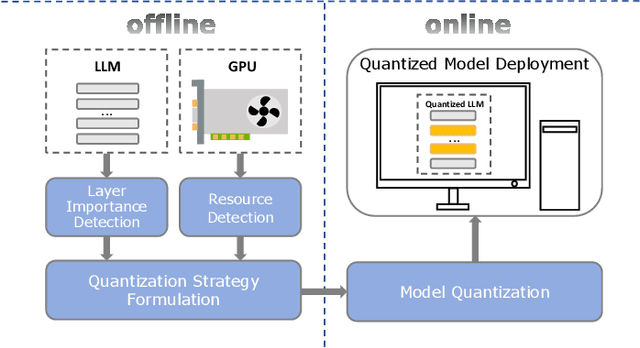

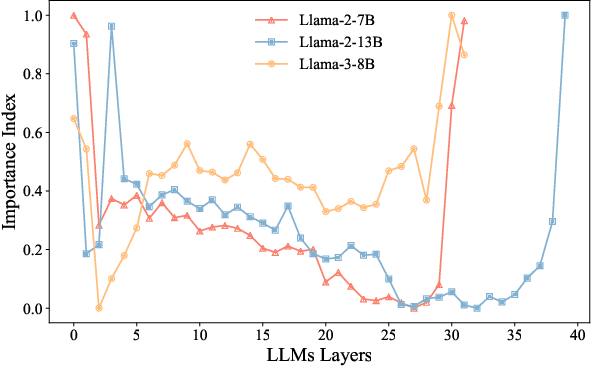
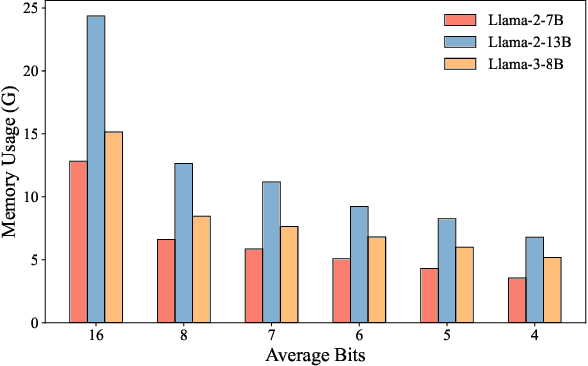
Abstract:As large language models (LLMs) demonstrate exceptional performance across various domains, the deployment of these models on edge devices has emerged as a new trend. Quantization techniques, which reduce the size and memory footprint of LLMs, are effective for enabling deployment on resource-constrained edge devices. However, existing one-size-fits-all quantization methods often fail to dynamically adjust the memory consumption of LLMs based on specific hardware characteristics and usage scenarios. To address this limitation, we propose LSAQ (Layer-Specific Adaptive Quantization), a system for adaptive quantization and dynamic deployment of LLMs based on layer importance. LSAQ evaluates layer importance by constructing top-k token sets from the inputs and outputs of each layer and calculating their Jaccard coefficient. Using this evaluation, the system adaptively adjusts quantization strategies in real time according to the resource availability of edge devices, assigning different precision levels to layers of varying importance. This approach significantly reduces the storage requirements of LLMs while maintaining model performance, enabling efficient deployment across diverse hardware platforms and usage scenarios.
MOSABench: Multi-Object Sentiment Analysis Benchmark for Evaluating Multimodal Large Language Models Understanding of Complex Image
Nov 25, 2024



Abstract:Multimodal large language models (MLLMs) have shown remarkable progress in high-level semantic tasks such as visual question answering, image captioning, and emotion recognition. However, despite advancements, there remains a lack of standardized benchmarks for evaluating MLLMs performance in multi-object sentiment analysis, a key task in semantic understanding. To address this gap, we introduce MOSABench, a novel evaluation dataset designed specifically for multi-object sentiment analysis. MOSABench includes approximately 1,000 images with multiple objects, requiring MLLMs to independently assess the sentiment of each object, thereby reflecting real-world complexities. Key innovations in MOSABench include distance-based target annotation, post-processing for evaluation to standardize outputs, and an improved scoring mechanism. Our experiments reveal notable limitations in current MLLMs: while some models, like mPLUG-owl and Qwen-VL2, demonstrate effective attention to sentiment-relevant features, others exhibit scattered focus and performance declines, especially as the spatial distance between objects increases. This research underscores the need for MLLMs to enhance accuracy in complex, multi-object sentiment analysis tasks and establishes MOSABench as a foundational tool for advancing sentiment analysis capabilities in MLLMs.
Model Editing for LLMs4Code: How Far are We?
Nov 11, 2024



Abstract:Large Language Models for Code (LLMs4Code) have been found to exhibit outstanding performance in the software engineering domain, especially the remarkable performance in coding tasks. However, even the most advanced LLMs4Code can inevitably contain incorrect or outdated code knowledge. Due to the high cost of training LLMs4Code, it is impractical to re-train the models for fixing these problematic code knowledge. Model editing is a new technical field for effectively and efficiently correcting erroneous knowledge in LLMs, where various model editing techniques and benchmarks have been proposed recently. Despite that, a comprehensive study that thoroughly compares and analyzes the performance of the state-of-the-art model editing techniques for adapting the knowledge within LLMs4Code across various code-related tasks is notably absent. To bridge this gap, we perform the first systematic study on applying state-of-the-art model editing approaches to repair the inaccuracy of LLMs4Code. To that end, we introduce a benchmark named CLMEEval, which consists of two datasets, i.e., CoNaLa-Edit (CNLE) with 21K+ code generation samples and CodeSearchNet-Edit (CSNE) with 16K+ code summarization samples. With the help of CLMEEval, we evaluate six advanced model editing techniques on three LLMs4Code: CodeLlama (7B), CodeQwen1.5 (7B), and Stable-Code (3B). Our findings include that the external memorization-based GRACE approach achieves the best knowledge editing effectiveness and specificity (the editing does not influence untargeted knowledge), while generalization (whether the editing can generalize to other semantically-identical inputs) is a universal challenge for existing techniques. Furthermore, building on in-depth case analysis, we introduce an enhanced version of GRACE called A-GRACE, which incorporates contrastive learning to better capture the semantics of the inputs.
Identifying Knowledge Editing Types in Large Language Models
Sep 29, 2024Abstract:Knowledge editing has emerged as an efficient approach for updating the knowledge of large language models (LLMs), attracting increasing attention in recent research. However, there is a notable lack of effective measures to prevent the malicious misuse of this technology, which could lead to harmful edits in LLMs. These malicious modifications have the potential to cause LLMs to generate toxic content, misleading users into inappropriate actions. To address this issue, we introduce a novel task, \textbf{K}nowledge \textbf{E}diting \textbf{T}ype \textbf{I}dentification (KETI), aimed at identifying malicious edits in LLMs. As part of this task, we present KETIBench, a benchmark that includes five types of malicious updates and one type of benign update. Furthermore, we develop four classical classification models and three BERT-based models as baseline identifiers for both open-source and closed-source LLMs. Our experimental results, spanning 42 trials involving two models and three knowledge editing methods, demonstrate that all seven baseline identifiers achieve decent identification performance, highlighting the feasibility of identifying malicious edits in LLMs. Additional analyses reveal that the performance of the identifiers is independent of the efficacy of the knowledge editing methods and exhibits cross-domain generalization, enabling the identification of edits from unknown sources. All data and code are available in https://github.com/xpq-tech/KETI. Warning: This paper contains examples of toxic text.
PTA: Enhancing Multimodal Sentiment Analysis through Pipelined Prediction and Translation-based Alignment
May 23, 2024
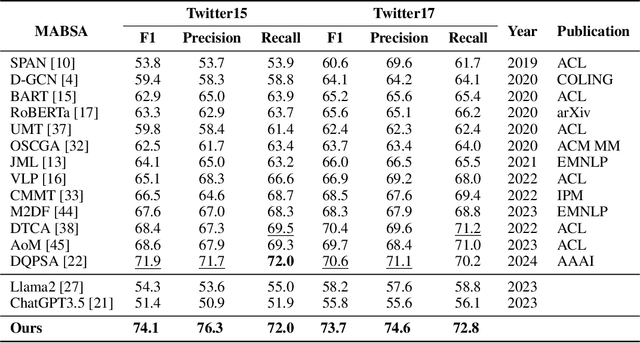


Abstract:Multimodal aspect-based sentiment analysis (MABSA) aims to understand opinions in a granular manner, advancing human-computer interaction and other fields. Traditionally, MABSA methods use a joint prediction approach to identify aspects and sentiments simultaneously. However, we argue that joint models are not always superior. Our analysis shows that joint models struggle to align relevant text tokens with image patches, leading to misalignment and ineffective image utilization. In contrast, a pipeline framework first identifies aspects through MATE (Multimodal Aspect Term Extraction) and then aligns these aspects with image patches for sentiment classification (MASC: Multimodal Aspect-Oriented Sentiment Classification). This method is better suited for multimodal scenarios where effective image use is crucial. We present three key observations: (a) MATE and MASC have different feature requirements, with MATE focusing on token-level features and MASC on sequence-level features; (b) the aspect identified by MATE is crucial for effective image utilization; and (c) images play a trivial role in previous MABSA methods due to high noise. Based on these observations, we propose a pipeline framework that first predicts the aspect and then uses translation-based alignment (TBA) to enhance multimodal semantic consistency for better image utilization. Our method achieves state-of-the-art (SOTA) performance on widely used MABSA datasets Twitter-15 and Twitter-17. This demonstrates the effectiveness of the pipeline approach and its potential to provide valuable insights for future MABSA research. For reproducibility, the code and checkpoint will be released.
Disentangling Instructive Information from Ranked Multiple Candidates for Multi-Document Scientific Summarization
Apr 16, 2024



Abstract:Automatically condensing multiple topic-related scientific papers into a succinct and concise summary is referred to as Multi-Document Scientific Summarization (MDSS). Currently, while commonly used abstractive MDSS methods can generate flexible and coherent summaries, the difficulty in handling global information and the lack of guidance during decoding still make it challenging to generate better summaries. To alleviate these two shortcomings, this paper introduces summary candidates into MDSS, utilizing the global information of the document set and additional guidance from the summary candidates to guide the decoding process. Our insights are twofold: Firstly, summary candidates can provide instructive information from both positive and negative perspectives, and secondly, selecting higher-quality candidates from multiple options contributes to producing better summaries. Drawing on the insights, we propose a summary candidates fusion framework -- Disentangling Instructive information from Ranked candidates (DIR) for MDSS. Specifically, DIR first uses a specialized pairwise comparison method towards multiple candidates to pick out those of higher quality. Then DIR disentangles the instructive information of summary candidates into positive and negative latent variables with Conditional Variational Autoencoder. These variables are further incorporated into the decoder to guide generation. We evaluate our approach with three different types of Transformer-based models and three different types of candidates, and consistently observe noticeable performance improvements according to automatic and human evaluation. More analyses further demonstrate the effectiveness of our model in handling global information and enhancing decoding controllability.
 Add to Chrome
Add to Chrome Add to Firefox
Add to Firefox Add to Edge
Add to Edge